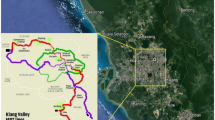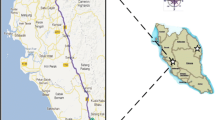Abstract
Robust and reliable design at certain levels of safety has earned lot of attention in recent. To build over the limitations of FOSM based reliability analysis, the paper proposes least square support vector machine (LSSVM), The Group Method of Data Handling (GMDH) and Gaussian process regression (GPR) based reliability analysis of pile group resting on cohesive soil. LSSVM is an improvement over support-vector machines (SVM) which uses linear systems instead of complex quadratic equations. GMDH is a self-organized neural network capable of solving complex non-linear problems. GPR is an effective Bayesian tool of machine learning the performance of the developed models is ascertained using various statistical parameters and Taylor curves. The reliability indices of the simulated values are compared to that of the actual values obtained from FOSM. The results show that all the models are applicable for reliability analysis of settlement of pile group.











Similar content being viewed by others
References
Alipour A, Jafari A, Hossaini SMF (2012) Application of ANNs and MVLRA for estimation of specific charge in small tunnel. Int J Geomech 12(2):189–192
Anderson TW, Darling DA (1952) Asymptotic theory of certain" goodness of fit" criteria based on stochastic processes. Ann Math Stat 23(2):193–212
Ardakani A, Kordnaeij A (2017) Soil compaction parameters prediction using GMDH-type neural network and genetic algorithm. Eur J Environ Civ Eng 23:1–14
Babu GS, Srivastava A (2007) Reliability analysis of allowable pressure on shallow foundation using response surface method. Comput Geotech 34(3):187–194
Behar O, Khellaf A, Mohammedi K (2015) Comparison of solar radiation models and their validation under Algerian climate—the case of direct irradiance. Energy Convers Manag 98:236–251
Burges CJC (1998) A tutorial on support vector machines for pattern recognition. Data Min Knowl Disc 2(2):121–167
Casagrande A (1965) Role of the calculated risk in earthwork and foundation engineering. J Soil Mech Found Div ASCE 91(4):1–40
Chan CL, Low BK (2009) Reliability analysis of laterally loaded piles involving nonlinear soil and pile behavior. J Geotech Geoenviron Eng 135(3):431–443
Cherubini C, Giasi CI, Rethati L (1993) The coefficients of variation of some geotechnical parameters. In: Proceedings of the conference on probabilistic methods in geotechnical engineering, pp 179–183, Canberra
Ching J, Phoon KK (2011) A quantile-based approach for calibrating reliability-based partial factors. Struct Saf 33(4–5):275–285
Cornell CA (1969) A probability-based structural code. ACI J 66:974–985
Das B (2008) Advanced soil mechanics. Taylor & Francis, London
Deng J (2006) Structural reliability analysis for implicit performance function using radial basis function network. Int J Solids Struct 43(3):255–291
Deng J, Gu D, Li X, Yue ZQ (2005) Structural reliability analysis for implicit performance functions using artificial neural network. Struct Saf 27(1):25–48
Despotovic M, Nedic V, Despotovic D, Cvetanovic S (2015) Review and statistical analysis of different global solar radiation sunshine models. Renew Sustain Energy Rev 52:1869–1880
Dodagoudar GR, Venkatachalam G (2000) Reliability analysis of slopes using fuzzy sets theory. Comput Geotech 27(2):101–115
Faravelli L (1989) Response surface approach for reliability analysis. J Eng Mech 115(12):2763–2781
Giasi CI, Masi P, Cherubini C (2003) Probabilistic and fuzzy reliability analysis of a sample slope near Aliano. Eng Geol 67(3–4):391–402
Godil, SS, Shamim MS, Enam SA, Qidwai U (2011) Fuzzy logic: a “simple” solution for complexities in neurosciences? Surg Neurol Int. 2(24).
Goh TH, Goh SH (2007) Support vector machines: their use in geotechnical engineering as illustrated using seismic liquefaction data. Comput Geotech 34:410–421
Gomes HM, Awruch AM (2004) Comparison of response surface and neural network with other methods for structural reliability analysis. J Struct Saf 26(1):49–67
Guan XL, Melchers RE (1997) Multitangent-plane surface method for reliability calculation. J Eng Mech 123(10):996–1002
Harr ME (1996) Reliability-based design in civil engineering. Dover Publications, Mineola
Hasofer AM, Lind NC (1974) An exact and invariant first order reliability format, ASCE. J Eng Mech Div 100(1):111–121
Hoeg K, Murarka RP (1974) Probabilistic analysis and design of a retaining wall. J Geotech Div ASCE 100(3):349–366
Holman D, Sridharan M, Gowda P, Porter D, Marek T, Howell T, Moorhead J (2014) Gaussian process models for reference ET estimation from alternative meteorological data sources. J Hydrol 517:28–35
Honjo Y, Suzuki MAKOTO, Shirato M, Fukui J (2002) Determination of partial factors for a vertically loaded pile based on reliability analysis. Soils Found 42(5):91–109
Ibrahim NM, Rahim NL, Amat RC, Salehuddin S, Ariffin NA (2012) Determination of plasticity index and compression index of soil at Perlis. Apcbee Procedia 4:94–98
Ivakhnenko AG (1971) Polynomial theory of complex systems. IEEE Trans Syst Man Cybern 4:364–378
Kordnaeij A, Kalantary F, Kordtabar B, Mola-Abasi H (2015) Prediction of recompression index using GMDH-type neural network based on geotechnical soil properties. Soils Found 55(6):1335–1345
Kecman V (2001) Learning and soft computing: support vector machines, neural networks, and fuzzy logic models. MIT Press, Cambridge
Kumar M, Bhatt MR, Samui P (2014) Modeling of elastic modulus of jointed rock mass: Gaussian process regression approach. Int J Geomech 14(3):1–4
Kwak K, Kim KJ, Huh J, Lee JH, Park JH (2010) Reliability-based calibration of resistance factors for static bearing capacity of driven steel pipe piles. Can Geotech J 47(5):528–538
Legates DR, McCabe GJ (2013) A refined index of model performance: a rejoinder. Int J Climatol 33:1053–1056
Li D, Chen Y, Lu W, Zhou C (2011) Stochastic response surface method for reliability analysis of rock slopes involving correlated non-normal variables. Comput Geotech 38(1):58–68
Lü Q, Low BK (2011) Probabilistic analysis of underground rock excavations using response surface method and SORM. Comput Geotech 38(8):1008–1021
Maalouf M, Khoury N, Trafalis TB (2008) Support vector regression to predict asphalt mix performance. Int J Numer Anal Meth Geomech 32:1989–1996
Mann HB, Whitney DR (1947) On a test of whether one of two random variables is stochastically larger than the other. Ann Math Stat, 18:50–60
Mollon G, Dias D, Soubra AH (2009) Probabilistic analysis of circular tunnels in homogeneous soil using response surface methodology. J Geotech Geoenviron Eng 135(9):1314–1325
Park DJ, Rilett L (1999) Forecasting freeway link travel times with a multilayer feed-forward neural network. Comput Aid Civ Infrastruct Eng 14(5):357–367
Pal M (2006) Support vector machines-based modelling of seismic liquefaction potential. Int J Numer Anal Meth Geomech 30:983–996
Phoon KK, Kulhawy FH (1999) Characterization of geotechnical variability. Can Geotech J 36(4):612–624
Phoon KK, Quek ST, Chow YK, Lee SL (1990) Reliability analysis of pile settlement. J Geotech Eng 116(11):1717–1735
Rajashekhar MR, Ellingwood BR (1993) A new look at the response surface approach for reliability analysis. Struct Saf 12(1):205–220
Rasmussen CE (2004) Gaussian processes in machine learning. In: Bousquet O, von Luxburg U, Rätsch G (eds) Advanced lectures on machine learning. ML 2003, Lecture notes in computer ccience, vol 3176. Springer, Berlin
Rasmussen CE, Williams CKI (2006) Gaussian process for machine learning. MIT Press, Cambridge, MA
Samui P (2008) Support vector machine applied to settlement of shallow foundations on cohesionless soils. Comput Goetech 35(3):419–427
Samui P, Kothari DP (2011) Utilization of a least square support vector machine (LSSVM) for slope stability analysis. Sci Iran 18(1):53–58
Samui P, Kurup P (2012) Multivariate adaptive regression spline (MARS) and least squares support vector machine (LSSVM) for OCR prediction. Soft Comput 16(8):1347–1351
Samui P, Sitharam T (2010) Site characterization model using artificial neural network and kriging. Int J Geomech 10(5):171–180
Stone R (1993) Improved statistical procedure for the evaluation of solar radiation estimation models. Sol Energy 51:289–291
Suykens JAK, Lukas L, Van DP, De MB, Vandewalle J (1999) Least squares support vector machine classifiers: a large scale algorithm. In: Proceedings of Eur conference circuit theory and design (ECCTD’99), Stresa, Italy, pp839–842
Suykens JA, De Brabanter J, Lukas L, Vandewalle J (2002) Weighted least squares support vector machines: robustness and sparse approximation. Neurocomputing 48(1–4):85–105
Suykens JAK, Horvath G, Basu S, Micchelli C, Vandewalle J (2003) Advances in learning theory: methods, models and applications, vol. 190, NATO-ASI Series III: computer and systems sciences, IOS Press, Amsterdam
Tandjiria V, The CI, Low BK (2000) Reliability analysis of laterally loaded piles using response surface methods. Struct Saf 22(4):335–355
Taylor KE (2001) Summarizing multiple aspects of model performance in a single diagram. J Geophys Res 106:7183–7192
Vapnik VN (1998) Statistical learning theory. Wiley, New York
Williams CK, Rasmussen CE (1996) Gaussian processes for regression, In: Advances in neural information processing systems, pp 514–520
Author information
Authors and Affiliations
Corresponding author
Additional information
Publisher's Note
Springer Nature remains neutral with regard to jurisdictional claims in published maps and institutional affiliations.
Rights and permissions
About this article
Cite this article
Kumar, M., Samui, P. Reliability Analysis of Settlement of Pile Group in Clay Using LSSVM, GMDH, GPR. Geotech Geol Eng 38, 6717–6730 (2020). https://doi.org/10.1007/s10706-020-01464-6
Received:
Accepted:
Published:
Issue Date:
DOI: https://doi.org/10.1007/s10706-020-01464-6




